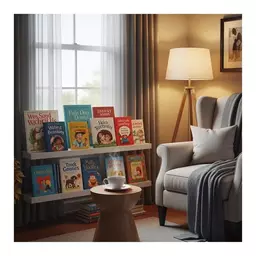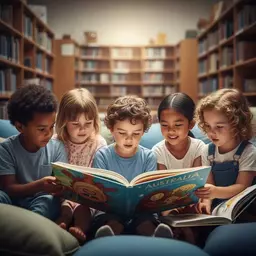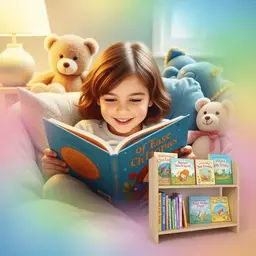Why Picture Books are Essential
- Illustrate key story elements
- Encourage imagination & creativity
- Engage reluctant readers
- Provide relatable characters & themes
In the world of storytelling, picture books hold a special place. They’re not just tales filled with vibrant illustrations; they are vital tools for teaching narrative writing to young minds. As educators, embracing these books can transform the way children perceive storytelling and enhance their writing skills. What are the key lessons here?
Picture books are vital tools in teaching narrative writing, effectively illustrating story elements, encouraging creativity, and engaging diverse learners. The visual below highlights their multifaceted benefits and how they support different learning styles. For more insights into fostering young readers, consider exploring how to boost your child's reading skills.
As a dedicated educator and advocate for children's literature, I firmly believe that picture books play a crucial role in teaching narrative writing. These charming stories do more than entertain—they serve as powerful tools that illustrate essential story elements like plot, character, and setting. By integrating picture books into writing instruction, we can help young learners grasp the complexities of narrative structure in a fun and engaging way!
Picture books are a fantastic way to spark creativity and inspire young writers. When children encounter well-crafted stories, they begin to see the possibilities of their own storytelling. This is especially important in developing their ability to express ideas coherently and fluently.
By utilizing picture books in the classroom, we can teach narrative writing in a way that resonates with students. For instance, they can witness firsthand how a story unfolds through visuals and text, making it easier to identify and understand critical components of storytelling.
Moreover, these books often present complex themes in a way that's accessible to young minds, allowing for deeper discussions and explorations into narrative techniques.
Every child learns differently, and picture books are a wonderful resource that caters to various learning styles. For visual learners, the striking illustrations breathe life into the story, making connections more vivid and memorable. Auditory learners benefit from the rhythm of language and storytelling, while kinesthetic learners can engage in activities inspired by the narratives they read.
This eclectic mix of engagement techniques ensures that all students can connect with and understand the material. As a mentor and guide, I often encourage parents and teachers to explore different picture books that align with their students' unique learning preferences!
For additional resources and ideas on engaging young readers, explore creative storytelling ideas for kids.
Visual literacy is an essential skill that complements students' understanding of narrative writing. When children engage with illustrations in picture books, they learn to interpret visual cues that enhance the storytelling experience. This understanding fosters their ability to analyze how images and text work together to convey meaning.
For example, a picture that shows a character's emotions can deepen a child's comprehension of that character's journey. By discussing these visual elements, we encourage children to think critically about both the narrative and the accompanying artwork, enriching their overall literary appreciation.
To enhance narrative writing skills in your students, consider using picture books as a springboard for creative exercises. After reading a book, encourage your students to rewrite the ending or create alternative perspectives from different characters' viewpoints. This not only fosters creativity but also deepens their understanding of narrative structure!
Creating a vibrant classroom community centered around storytelling is essential for fostering a love of narrative writing. As educators, we can inspire our students to explore their imaginative capabilities and share their unique voices. When we cultivate an environment that encourages creativity and collaboration, students become more engaged and confident in their writing abilities.
A supportive classroom atmosphere allows children to express themselves freely. It’s important to provide opportunities where every student feels heard and valued. To achieve this, consider these key strategies:
By implementing these approaches, we can help nurture a classroom culture that not only values storytelling but also enhances students' narrative writing skills!
As teachers, having access to a wealth of resources can significantly bolster our teaching of narrative writing with picture books. Below are some valuable materials and communities that can support your journey:
These resources not only enhance our teaching practices but also connect us with a broader community of educators who are passionate about nurturing young writers at Kids Book Guide! Discover more about essential children's books for schools to further enrich your classroom library.
Starting your narrative writing lessons using picture books can be an exciting adventure! Here’s a simple step-by-step approach to help you kick off effectively:
Following these steps not only makes the lesson structured but also allows students to delve deep into their creativity while learning valuable writing skills!
Sharing experiences with colleagues can greatly enrich our collective knowledge about teaching narrative writing. I encourage you to discuss your successes and challenges when using picture books in your lessons. By sharing stories, we can inspire one another and discover new strategies that enhance our teaching practices.
Consider organizing regular staff meetings or informal gatherings where teachers can share their insights. You might also think about creating a shared online document where everyone can contribute their experiences, tips, and favorite picture books. This collaborative approach fosters a sense of community among educators at Kids Book Guide!
Developing effective lesson plans that integrate picture books into narrative writing instruction can significantly enhance student engagement. Here’s a straightforward guide to help you create impactful lesson plans:
By following these steps, you can create engaging lesson plans that inspire your students to explore the wonderful world of narrative writing through picture books! Remember, at Kids Book Guide, we are committed to nurturing young readers, and your dedication makes a huge difference in their learning journey.
A: Picture books effectively illustrate key story elements such as plot, character, and setting, making complex narrative structures accessible to young learners. Their visual nature also aids in understanding the connection between text and images.
A: Yes, the vibrant illustrations and engaging stories in picture books can capture the attention of reluctant readers, making the learning process more enjoyable and less intimidating.
A: Picture books cater to visual learners through illustrations, auditory learners through read-aloud sessions, and kinesthetic learners through activities like acting out stories or crafting based on themes.
A: Visual literacy is the ability to interpret and make meaning from images. In narrative writing, it helps students understand how visuals and text work together to convey meaning, deepening their comprehension and analytical skills.
A: Teachers can find valuable resources through online workshops (e.g., International Literacy Association), professional publications like “The Writing Teacher,” and social media groups focused on literacy education.
Here is a quick recap of the important points discussed in the article:

 As you navigate the vibrant world of children's literature, think about how a simple signature can t
As you navigate the vibrant world of children's literature, think about how a simple signature can t
 What if the right book could unlock your child's imagination and build their future? Understanding a
What if the right book could unlock your child's imagination and build their future? Understanding a
 Reading stories isn't just a pastime; it's a powerful catalyst for children's education. Australian
Reading stories isn't just a pastime; it's a powerful catalyst for children's education. Australian
 In the words of Aveline Carter, "The journey of discovering books can be just as exciting as reading
In the words of Aveline Carter, "The journey of discovering books can be just as exciting as reading